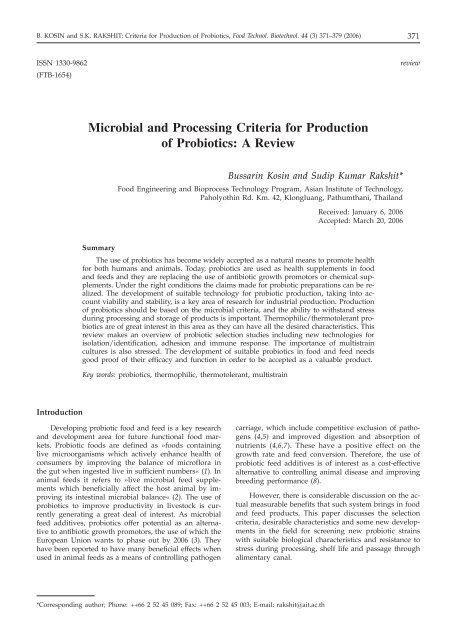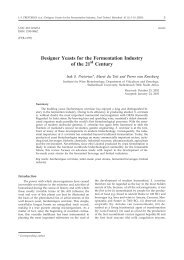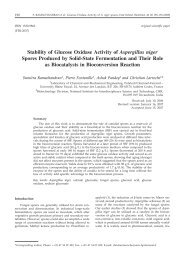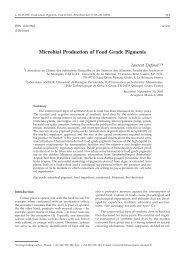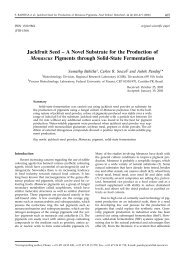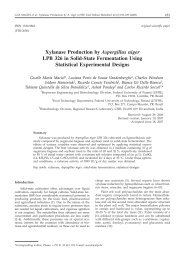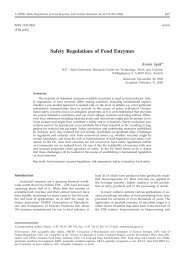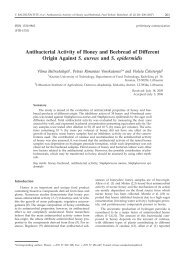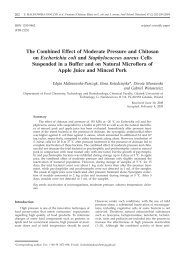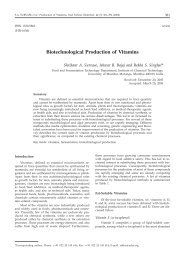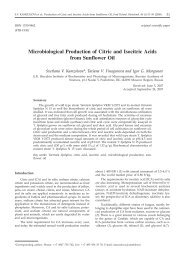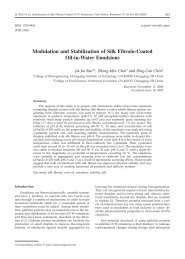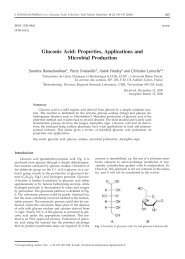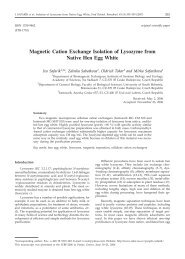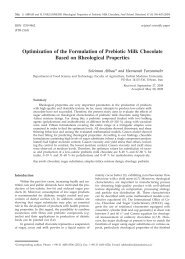A Review - Food Technology and Biotechnology
A Review - Food Technology and Biotechnology
A Review - Food Technology and Biotechnology
You also want an ePaper? Increase the reach of your titles
YUMPU automatically turns print PDFs into web optimized ePapers that Google loves.
B. KOSIN <strong>and</strong> S.K. RAKSHIT: Criteria for Production of Probiotics, <strong>Food</strong> Technol. Biotechnol. 44 (3) 371–379 (2006)<br />
371<br />
ISSN 1330-9862<br />
(FTB-1654)<br />
review<br />
Microbial <strong>and</strong> Processing Criteria for Production<br />
of Probiotics: A <strong>Review</strong><br />
Bussarin Kosin <strong>and</strong> Sudip Kumar Rakshit*<br />
<strong>Food</strong> Engineering <strong>and</strong> Bioprocess <strong>Technology</strong> Program, Asian Institute of <strong>Technology</strong>,<br />
Paholyothin Rd. Km. 42, Klongluang, Pathumthani, Thail<strong>and</strong><br />
Received: January 6, 2006<br />
Accepted: March 20, 2006<br />
Summary<br />
The use of probiotics has become widely accepted as a natural means to promote health<br />
for both humans <strong>and</strong> animals. Today, probiotics are used as health supplements in food<br />
<strong>and</strong> feeds <strong>and</strong> they are replacing the use of antibiotic growth promotors or chemical supplements.<br />
Under the right conditions the claims made for probiotic preparations can be realized.<br />
The development of suitable technology for probiotic production, taking into account<br />
viability <strong>and</strong> stability, is a key area of research for industrial production. Production<br />
of probiotics should be based on the microbial criteria, <strong>and</strong> the ability to withst<strong>and</strong> stress<br />
during processing <strong>and</strong> storage of products is important. Thermophilic/thermotolerant probiotics<br />
are of great interest in this area as they can have all the desired characteristics. This<br />
review makes an overview of probiotic selection studies including new technologies for<br />
isolation/identification, adhesion <strong>and</strong> immune response. The importance of multistrain<br />
cultures is also stressed. The development of suitable probiotics in food <strong>and</strong> feed needs<br />
good proof of their efficacy <strong>and</strong> function in order to be accepted as a valuable product.<br />
Key words: probiotics, thermophilic, thermotolerant, multistrain<br />
Introduction<br />
Developing probiotic food <strong>and</strong> feed is a key research<br />
<strong>and</strong> development area for future functional food markets.<br />
Probiotic foods are defined as »foods containing<br />
live microorganisms which actively enhance health of<br />
consumers by improving the balance of microflora in<br />
the gut when ingested live in sufficient numbers« (1). In<br />
animal feeds it refers to »live microbial feed supplements<br />
which beneficially affect the host animal by improving<br />
its intestinal microbial balance« (2). The use of<br />
probiotics to improve productivity in livestock is currently<br />
generating a great deal of interest. As microbial<br />
feed additives, probiotics offer potential as an alternative<br />
to antibiotic growth promotors, the use of which the<br />
European Union wants to phase out by 2006 (3). They<br />
have been reported to have many beneficial effects when<br />
used in animal feeds as a means of controlling pathogen<br />
carriage, which include competitive exclusion of pathogens<br />
(4,5) <strong>and</strong> improved digestion <strong>and</strong> absorption of<br />
nutrients (4,6,7). These have a positive effect on the<br />
growth rate <strong>and</strong> feed conversion. Therefore, the use of<br />
probiotic feed additives is of interest as a cost-effective<br />
alternative to controlling animal disease <strong>and</strong> improving<br />
breeding performance (8).<br />
However, there is considerable discussion on the actual<br />
measurable benefits that such system brings in food<br />
<strong>and</strong> feed products. This paper discusses the selection<br />
criteria, desirable characteristics <strong>and</strong> some new developments<br />
in the field for screening new probiotic strains<br />
with suitable biological characteristics <strong>and</strong> resistance to<br />
stress during processing, shelf life <strong>and</strong> passage through<br />
alimentary canal.<br />
*Corresponding author; Phone: ++66 2 52 45 089; Fax: ++66 2 52 45 003; E-mail: rakshit@ait.ac.th
372 B. KOSIN <strong>and</strong> S.K. RAKSHIT: Criteria for Production of Probiotics, <strong>Food</strong> Technol. Biotechnol. 44 (3) 371–379 (2006)<br />
Selection of Probiotics for Animal Feed<br />
Production<br />
A summary of conventional criteria that can be used<br />
for the selection of microbial strains to be used as probiotics<br />
includes the following properties (1,8):<br />
• Biosafety: the strains of microorganisms should be Generally<br />
Recognized As Safe (GRAS microorganisms),<br />
for example, Lactobacillus species or some Bifidobacterium<br />
<strong>and</strong> Streptococcus (Enterococcus) species.<br />
• The choice of the origin of the strain: probiotics should<br />
preferentially originate from the target animal microflora.<br />
This choice is determined by the specific purpose<br />
of the application of the probiotics (e.g. location<br />
specificity or requirement for colonization). The<br />
strains should be properly isolated <strong>and</strong> identified<br />
before use.<br />
• Resistance to in vivo/vitro conditions: after administration<br />
of the probiotic, the microorganisms should not<br />
be killed by the defense mechanisms of the host <strong>and</strong><br />
they should be resistant to the specific conditions<br />
occurring in the body. They should be resistant to<br />
the pH, bile <strong>and</strong> pancreatic juice conditions.<br />
• Adherence <strong>and</strong> colonization of intestinal epithelium/tissue:<br />
factors that affect colonization should be considered.<br />
These should include the resistance of bacteria themselves,<br />
the effect of gastrointestinal environment (ingredient,<br />
pH, bile, salt, etc.) on colonization, the existing<br />
microbes that exert interacting factors (probiotics-host-microflora<br />
interactions), etc.<br />
• Antimicrobial activity/antagonisms to pathogens: lactic<br />
acid bacteria, which are frequently used as probiotics,<br />
have a number of antagonistic properties which<br />
operate by decreasing pH by the production of lactic<br />
acid, consumption of available nutrients, decreasing<br />
the redox potential, production of hydrogen peroxide<br />
under aerobic conditions, production of specific<br />
inhibitory components, such as bacteriocines, etc.,<br />
<strong>and</strong> which would help to protect against pathogenic<br />
organisms. This is important for the probiotics to be<br />
effective.<br />
• Stimulation of immune response<br />
• Viability/survival <strong>and</strong> resistance during processing (e.g.<br />
heat tolerance or storage)<br />
The choices of mono or multi strains, beneficial systematic<br />
effects (e.g. prebiotic-synbiotic system) <strong>and</strong> other<br />
properties such as oxygen tolerance, selective stimulation<br />
of beneficial bacteria <strong>and</strong> suppression of harmful bacteria<br />
are also considered (9).<br />
Based on these predetermined criteria <strong>and</strong> specific<br />
properties that are desired, it should be possible to select<br />
the best commercially available probiotics that can<br />
be helpful therapeutically <strong>and</strong> nutritionally. However,<br />
the criteria for probiotics in feed need not be as specific<br />
as those required for food applications.<br />
Viability of Probiotic Organisms<br />
Viability <strong>and</strong> stability of probiotics has been both a<br />
marketing <strong>and</strong> technological challenge for industrial producers.<br />
For the probiotics to be functional they have to<br />
be viable <strong>and</strong> in sufficient dosage levels (10). The production<br />
of probiotic supplements for food/feed requires<br />
that the strains maintain a suitable level of viable cell<br />
count during the processing of the product <strong>and</strong> its shelf<br />
life. Once a desirable culture is selected, the technological<br />
dem<strong>and</strong>s placed on probiotic strains are great <strong>and</strong><br />
new manufacturing process <strong>and</strong> formulation technologies<br />
may often be required to retain viability <strong>and</strong> hence<br />
functional health properties. Before probiotic strains can<br />
be delivered to food/feed products, they should survive<br />
processing <strong>and</strong> gastrointestinal stress factors <strong>and</strong> maintain<br />
their biological function within the host (11). All of<br />
these criteria need to be taken into account in the choice<br />
of a probiotic strain.<br />
Microencapsulation is an available technology which<br />
allows probiotics to be formulated into food systems<br />
<strong>and</strong> helps them preserve their viability to be delivered<br />
into the gastrointestinal tract. Thermal processing for obtaining<br />
a storable form of the probiotics, <strong>and</strong> the choice<br />
of proper feed matrix suitable for retaining the viability<br />
of the probiotic during the production of the pellet need<br />
to be appropriate.<br />
Thermophilic/thermotolerant organisms have an<br />
advantage in that they withst<strong>and</strong> higher temperature<br />
during processing <strong>and</strong> storage (12,13). They have a better<br />
chance of remaining viable during the drying process<br />
required for prolonged storage <strong>and</strong> they lead to a<br />
distinctly effective product. Attempts are thus being<br />
made to select or isolate thermophilic/thermotolerant<br />
probiotics from the available sources <strong>and</strong> examine the<br />
survival of these strains during spray drying <strong>and</strong> to define<br />
the optimal processing parameters for obtaining the<br />
best products.<br />
To achieve health benefits, probiotic bacteria must<br />
be viable <strong>and</strong> available at a high concentration, typically<br />
10 6 –10 7 CFU/g of product (14). In different countries<br />
specific requirements vary depending on products. Despite<br />
the importance of viability, surveys conducted to<br />
validate viability claims have shown low populations of<br />
probiotic bacteria in probiotic foods (15). Several factors<br />
have been claimed to be responsible for the loss of viability<br />
of probiotic organisms: acidity of products, acid produced<br />
during refrigerated storage (post acidification),<br />
level of oxygen in products, oxygen permeation through<br />
the package, sensitivity to antimicrobial substances produced<br />
by bacteria (16). Strategies to improve viability of<br />
probiotic organisms are appropriate selection of acid <strong>and</strong><br />
bile resistant strains, use of oxygen impermeable containers,<br />
two-step fermentation, microencapsulation, stress<br />
adaptation, <strong>and</strong> incorporation of micronutrients such as<br />
peptides <strong>and</strong> amino acids. The survival of the strains<br />
during the passage through the stomach can be studied<br />
in vitro in gastric juice. Study showed that, among several<br />
strains of L. acidophilus <strong>and</strong> Bifidobacterium spp., only<br />
a few strains survived under the acidic conditions <strong>and</strong><br />
bile concentrations normally encountered in fermented<br />
products or in the gastrointestinal tract (15). Once a desirable<br />
culture, which is resistant to acid <strong>and</strong> bile conditions,<br />
is selected, it must be stable with regard to viability<br />
<strong>and</strong> level of activity during production <strong>and</strong> storage.<br />
Most food/feed manufacturers use strains of probiotic<br />
that can retain their viability (i.e. remain alive <strong>and</strong> grow<br />
well to high number) through the manufacturing pro-
B. KOSIN <strong>and</strong> S.K. RAKSHIT: Criteria for Production of Probiotics, <strong>Food</strong> Technol. Biotechnol. 44 (3) 371–379 (2006)<br />
373<br />
cess, storage conditions, the product’s shelf life, <strong>and</strong> the<br />
distribution times.<br />
Thermophilic LAB (T-LAB)<br />
Thermophilic lactic acid bacteria (T-LAB) are well-<br />
-known for their biotechnological importance in the production<br />
of cheeses <strong>and</strong> fermented milk, which all require<br />
incubation of milk or curd at a relatively high<br />
temperature (45 °C or above) during their production<br />
process. Thermophilic bacteria that are mainly used as<br />
dairy starters belong to three species: Streptococcus thermophilus,<br />
Lactobacillus helveticus, <strong>and</strong> Lactobacillus delbrueckii<br />
ssp. bulgaricus or lactis (17,18). L. casei <strong>and</strong> L.<br />
plantarum are also grouped in thermophiles <strong>and</strong> used in<br />
dairy products. Delcour et al. (19) have reviewed the genetic<br />
<strong>and</strong> other important characteristics required to underst<strong>and</strong><br />
T-LAB. The manner in which they exploit milk<br />
protein <strong>and</strong> sugar, adapt to stress, <strong>and</strong> horizontally exchange<br />
genetic information which may help in screening<br />
the T-LAB from the available sources is described in the<br />
following paragraphs.<br />
Proteolytic systems<br />
The ability to produce a cell wall-bound extracellular<br />
proteinases (CEP) is a very important feature of<br />
T-LAB in the hydrolysis of milk proteins (casein), providing<br />
the cells with the amino acids that are essential for<br />
growth of LAB. Cell envelope-associated proteinases are<br />
detected <strong>and</strong> characterized in various thermophilic lactobacilli<br />
(20–23). Genes encoding a cell wall-bound protease<br />
in T-LAB are prtB, prtH, prtY <strong>and</strong> prtS. For LAB<br />
peptidases, gene encoding are PepC, PepN, PepS <strong>and</strong><br />
PepO. Screening of thermophilic/thermotolerant lactobacilli<br />
based on proteolytic activity is another method to<br />
identify thermophilic probiotics with the information of<br />
the cell wall-bound proteinase characteristics. Further<br />
genetic information is considered useful to improve know<br />
ledge of the functional properties of LAB <strong>and</strong> T-LAB.<br />
Stress response<br />
During the yogurt <strong>and</strong> cheese making process, T-LAB<br />
are exposed to various changes in environmental parameters<br />
(heat, acidity, salt, cold, etc.) <strong>and</strong> induce adaptive<br />
responses allowing them to cope with the resulting physiological<br />
stresses (19). The GroES, GroEL, <strong>and</strong> DnaK<br />
proteins were found to be both heat- <strong>and</strong> acid-shock inducible<br />
in L. delbrueckii ssp. bulgaricus. A gene encoding<br />
a small 17 kDa heat-shock protein widely distributed in<br />
prokaryotic <strong>and</strong> eukaryotic organisms was reported to<br />
be plasmid-encoded in various S. thermophilus strains<br />
(24,25).<br />
Other important genetic information on characteristics<br />
of T-LAB are sugar uptake <strong>and</strong> glycolysis, catabolite<br />
repression, exopolysaccharides, horizontal gene transfer,<br />
bacteriophage resistance, etc. (19). Such fundamental<br />
knowledge can be applied in the future for the improvement<br />
of T-LAB starters <strong>and</strong> in other fields of study using<br />
these microorganisms for further applications.<br />
Recent Studies on Processing of<br />
Thermophilic/Thermotolerant Lactic<br />
Acid Bacteria<br />
A major challenge associated with the application of<br />
probiotic cultures in functional foods is the retention of<br />
viability during processing. Some studies have demonstrated<br />
that following spray drying, probiotics show increased<br />
sensitivity to cell wall, cell membrane <strong>and</strong> DNA<br />
damage (26,27). A number of approaches have been examined<br />
with a view of improving culture viability during<br />
spray drying. The survival of thermophilic probiotic cultures<br />
(e.g. L. paracasei) during cheese making <strong>and</strong> spray<br />
drying has been successful. Up to 49 % survival was obtained<br />
following spray drying at an outlet temperature<br />
of 80–85 °C (13). Some thermophilic lactic acid bacteria<br />
isolated <strong>and</strong> identified from dairy products (28) were<br />
classified as Lactobacillus delbrueckii ssp. lactis <strong>and</strong> ssp.<br />
bulgaricus, L. helveticus <strong>and</strong> L. acidophilus. Nitisinprasert<br />
et al. (29) successfully isolated effective thermotolerant<br />
lactobacilli which exerted broad spectrum inhibition specific<br />
(SIS) results from chicken intestine <strong>and</strong> they were<br />
classified as Lactobacillus reuteri. Identification of new thermotolerant<br />
species of lactic acid bacteria isolated from<br />
animal hosts like chicken has been conducted recently<br />
using molecular identification method. New isolated thermotolerant<br />
species from chicken faeces are Lactobacillus<br />
thermotolerans (30) <strong>and</strong> Lactobacillus aminata sp. nov., <strong>and</strong><br />
some species belong to Lactobacillus paraplantarum (31).<br />
The effect of heat shock <strong>and</strong> the induction of a stress<br />
response in Lactobacillus spp. have been studied for several<br />
thermophilic LAB (13,32–39). Methods of heat tolerance<br />
of mesophilic Lactobacilli are studied using pressure<br />
pretreatment on human origin L. rhamnosus GG<br />
(40). Cells exposed to pressure pretreatment showed<br />
higher survival than untreated cells when exposed to<br />
high temperature at 60 °C <strong>and</strong> heat adapted method<br />
showed greater thermotolerance compared to the control<br />
(40,41). Heat adaptation with cross-protection (e.g.<br />
heat exposure <strong>and</strong> simultaneous exposure to sublethal<br />
levels of hydrogen peroxide or bile salts or NaCl) was<br />
also studied to induce against heat stress of L. paracasei<br />
ssp. paracasei (41). The effect of a combination of factors<br />
(e.g. ethanol <strong>and</strong> pH) on heat resistance of thermophilic<br />
L. delbrueckii was investigated by Casadei et al. (42). Silva<br />
et al. (43) showed the induction of stress tolerance by the<br />
addition of sucrose to the growth medium as the accumulated<br />
compatible solutes during short period of drying<br />
process <strong>and</strong> storage. Saarela et al. (44) reported that<br />
sublethal treatments of acid <strong>and</strong> heat treatments of stationary<br />
phase probiotic cultures (Lactobacilli strains) improved<br />
the viability <strong>and</strong> enhanced their survival during<br />
lethal treatments <strong>and</strong> their ability to adapt these treatments<br />
at fermentor-scale production of probiotic cultures.<br />
Therefore, strain-specific treatments <strong>and</strong> sublethal treatments<br />
of specific growth phase probiotic cells can be utilized<br />
in the production of probiotic cultures with improved<br />
viability. The methods of pretreatment, heat<br />
adaptation <strong>and</strong> other factors that affect such investigation<br />
are very important for further studies on the viability<br />
of probiotic bacteria during heat processing.<br />
Study of fatty acid modification in relation to the<br />
temperature is also a method to discriminate T-LAB
374 B. KOSIN <strong>and</strong> S.K. RAKSHIT: Criteria for Production of Probiotics, <strong>Food</strong> Technol. Biotechnol. 44 (3) 371–379 (2006)<br />
strains (30). The changes in lipid composition enable the<br />
microorganisms to maintain membrane functions in the<br />
face of environmental fluctuations. In particular, temperature-induced<br />
variations in lipid composition of bacteria<br />
are generally thought to be associated with the regulation<br />
of liquid crystalline to gel phase transition temperature<br />
for the maintenance of an ideal »functional« physiological<br />
state of cell membrane.<br />
Interest in the stress response phenomenon of LAB<br />
species has grown (26,37). Underst<strong>and</strong>ing the mechanism<br />
of stress may lead to the development of cultures<br />
with improved capacity to survive <strong>and</strong> function under<br />
industrial production conditions. Examination of the<br />
increased degree of thermotolerance <strong>and</strong> suitability for<br />
spray drying conferred on probiotics by adaptation to<br />
different stresses is another challenging step being addressed.<br />
In addition, the effects of various rehydration<br />
conditions on culture performance should be taken into<br />
account, given that resuscitation of dried cultures may<br />
represent a critical control point in obtaining effective<br />
probiotic strains.<br />
Probiotic Selection, Isolation <strong>and</strong><br />
Methodology Development<br />
Since genetic stability is also required in probiotics,<br />
isolated specified target of functional strain needs to be<br />
identified. LAB belonging to the genus Lactobacillus have<br />
been isolated from a variety of habitats, including plant<br />
<strong>and</strong> dairy products, meat products, sewage <strong>and</strong> manure,<br />
<strong>and</strong> humans <strong>and</strong> animals. Several isolates from animal<br />
host like chicken were found to be acid <strong>and</strong> bile tolerant<br />
(45–47). Although several Lactobacillus spp. have been<br />
isolated from chicken faeces, most of the strains isolated<br />
so far have been mesophiles. However, the isolation of<br />
Lactobacillus spp. from chicken faeces under high temperatures<br />
has been studied <strong>and</strong> reported by Niamsup et<br />
al. (30). In their studies, they isolated a large number of<br />
LAB from various types of natural samples at relatively<br />
high temperatures, i.e. 40–50 °C. A recent study (48) used<br />
species <strong>and</strong> group-specific 16S rRNA-targeted oligonucleotide<br />
probes, dot blot hybridization (DNA-DNA hybridization)<br />
<strong>and</strong> fluorescent in situ hybridization (FISH)<br />
methods. The probes were designed in a way that some<br />
of the T-LAB detect novel species of L. thermotolerans<br />
<strong>and</strong> other LAB in chicken faeces. FISH analysis performed<br />
with group-specific 16S rRNA-targeted oligonucleotide<br />
probes was also successively used to analyze<br />
the fecal microflora of host consuming probiotic product<br />
containing specific lactobacilli (48).<br />
The use of PCR assay (polymerase chain reaction)<br />
method with the 16S rRNA analysis has been studied in<br />
many works on identification of organisms isolated from<br />
chicken host, human faeces <strong>and</strong> animal feed (49–52). A<br />
new real-time quantitative PCR with 16S rRNA gene-targeted<br />
species/group-specific primers has recently been<br />
introduced to analyze LAB in intestine <strong>and</strong> faeces of human<br />
host (53–55). A real-time PCR assay for rapid <strong>and</strong><br />
sensitive detection of a novel thermotolerant bacterium,<br />
Lactobacillus thermotolerans, in chicken faeces was developed<br />
<strong>and</strong> assessed by Selim et al. (56). Whole-cell protein<br />
profiling method by SDS PAGE is an additional studied<br />
method to help identify a new thermotolerant<br />
species of LAB isolated from chicken faeces (31) <strong>and</strong> to<br />
identify the isolates from 55 European probiotic products<br />
(57).<br />
A novel multiplex polymerase chain reaction (PCR)<br />
primer set for the identification of a number of probiotic<br />
Lactobacillus species simultaneously has been developed<br />
(58). It uses the primer sets comprising of specific <strong>and</strong><br />
two conserved primers derived from the integrated sequences<br />
of 16S <strong>and</strong> 23S rRNA genes <strong>and</strong> their rRNA<br />
intergenic spacer region of each species with 93.6 % accuracy.<br />
This exceeds the accuracy of the general biochemical<br />
methods. The phylogenetic analyses, using 16S<br />
rDNA sequences of the probiotic isolates, also provided<br />
further support that the results from the multiplex PCR<br />
assay were trustworthy. The results suggested that the<br />
multiplex primer set of PCR is an efficient tool for simple,<br />
rapid <strong>and</strong> reliable identification of seven Lactobacillus<br />
species.<br />
Adhesion/colonization<br />
Adhesion <strong>and</strong> colonization are important for selection<br />
<strong>and</strong> use of probiotic strains. Scanning electron microscope<br />
(SEM) has been introduced to study the density<br />
<strong>and</strong> survival of probiotics in chicken intestine after feeding<br />
chicken with the probiotic supplements (59). Different<br />
methods are used to study bacterial adhesion to intestinal<br />
epithelial cells, which is an important step in<br />
pathogenic infection as well as in probiotic colonization<br />
of the intestinal tract. Le Blay et al. (60) conducted comparative<br />
detection of bacterial adhesion to Caco-2 cells<br />
with ELISA, radioactivity <strong>and</strong> plate count methods. The<br />
methods tested gave similar results for the highest bacterial<br />
concentrations. However, differences among methods<br />
increased with the addition of decreased bacterial<br />
concentration due to different detection thresholds. The<br />
ELISA-based method was shown to be a good predictor<br />
for bacterial adhesion compared to the radiolabelling<br />
method when good quality specific antibodies were used.<br />
This technique is convenient <strong>and</strong> allows h<strong>and</strong>ling of numerous<br />
samples. Fluorescent staining of Lactobacillus<br />
<strong>and</strong> Bifidobacterium strains <strong>and</strong> a Bifidobacterium mixture<br />
using the viable probe carboxyfluorescein diacetate was<br />
attempted. These cells were incubated on Caco-2 monolayers<br />
<strong>and</strong> subsequent spectrofluorimetric detection following<br />
the lysis of the attached bacterial cells was done.<br />
The results were expressed as adhesion percentage (61),<br />
<strong>and</strong> they proved that fluorescent labelling is suitable for<br />
adhesion studies <strong>and</strong> provides a reliable <strong>and</strong> safer alternative<br />
to radioactive labelling.<br />
Immune response<br />
Transmission electron microscopy (TEM) was used<br />
to determine how probiotic strains in contact with intestinal<br />
epithelia result in an immune response in mice (10).<br />
Development <strong>and</strong> validation of a new in vitro assay for<br />
selection of probiotic bacteria that express immune-stimulating<br />
properties in chickens in vivo was studied by Koenen<br />
et al. (62). They used an in vitro system for rapid<br />
preselection of LAB with immunomodulating properties.<br />
For T-cell proliferation following mitogenic stimulation,<br />
activation of accessory cells is required. The pre-selection<br />
assay was based on a concanavalin A (ConA)
B. KOSIN <strong>and</strong> S.K. RAKSHIT: Criteria for Production of Probiotics, <strong>Food</strong> Technol. Biotechnol. 44 (3) 371–379 (2006)<br />
375<br />
mitogen-induced lymphocyte proliferation assay, in which<br />
enhancement or inhibition of the response was the result<br />
of the immunomodulating properties of LAB for which<br />
either T-cells or accessory cells may be sensitive.<br />
Multistrain Selection<br />
According to some authors, functionality of a multistrain/multispecies<br />
probiotics could be more effective<br />
<strong>and</strong> more consistent than that of a monostrain (63,64).<br />
Studies on the interactions among lactic acid starter <strong>and</strong><br />
probiotic bacteria have been investigated to establish<br />
adequate combinations of strains (65). A required dosage<br />
of the probiotic supplemented with normal feed should<br />
be ascertained depending on a delivery pattern <strong>and</strong> form<br />
of probiotic products when incorporated into animal feed.<br />
This review cites recent studies <strong>and</strong> methods of development<br />
of probiotics for potential functional food/feed<br />
products.<br />
Functionality of a multistrain probiotic could be<br />
more effective <strong>and</strong> more consistent than that of monostrain<br />
probiotic. Colonization of an ecosystem providing<br />
a niche for more than 400 species in combination with<br />
individually determined host-factors is anticipated to be<br />
more successful with multistrain (multispecies) of probiotics<br />
than monostrain preparations (66,67). Interaction<br />
among lactic acid starter <strong>and</strong> probiotic bacteria has been<br />
investigated to establish adequate combinations of strains<br />
to manufacture probiotic dairy products using strains of<br />
Streptococcus thermophilus, Lactobacillus delbrueckii ssp.<br />
bulgaricus, Lactococcus lactis, Lactobacillus acidophilus, Lactobacillus<br />
casei, <strong>and</strong> Bifidobacterium spp. (63). The detection<br />
of bacterial interactions was carried out using well-<br />
-diffusion agar assay, <strong>and</strong> the interactions found were<br />
further characterized by growth kinetics. The study of<br />
interactions by growth kinetics allowed the setting of<br />
four different kinds of behaviour between species of lactic<br />
acid starter <strong>and</strong> probiotic bacteria (stimulation, delay,<br />
complete inhibition of growth, <strong>and</strong> no effects among<br />
them). The possible interactions among the strains selected<br />
should be considered when choosing the best combinations<br />
in order to optimize their performance in the<br />
process <strong>and</strong> their survival in the products (65). Recently,<br />
functionality <strong>and</strong> efficacy of monostrain, multistrain <strong>and</strong><br />
multispecies probiotics have been summarized by Timmerman<br />
et al. (63). From a wide range of work trials in<br />
different hosts, multispecies probiotics were found to be<br />
superior in treating antibiotic-associated diarrhea in children,<br />
improve growth performance <strong>and</strong> particularly mortality<br />
in broilers <strong>and</strong> showed better protected mice against<br />
S. typhimurium infection. Also, multispecies probiotics provided<br />
the best clearance of E. coli O157:H7 from lambs<br />
(63). Rats challenged with S. enteritidis showed best post-<br />
-challenge mass gain when treated with multispecies<br />
probiotics. Possible mechanisms underlying the enhanced<br />
effects of probiotic mixtures are also discussed (63).<br />
It is emphasized that strains used in multistrain <strong>and</strong><br />
multispecies probiotics should be compatible <strong>and</strong> preferably<br />
synergistic. The design <strong>and</strong> use of multistrain <strong>and</strong><br />
multispecies probiotics need to be studied well before<br />
use.<br />
Application of Probiotics in Feed Processing<br />
Probiotics are incorporated into animal feed as one<br />
of specific additives (including antioxidants, binding<br />
agents, preservatives, enzymes) in different ways (e.g.<br />
during or after processing or top-dressing feed mix). In<br />
Europe this comes under strict legislation for reared species<br />
or groups of species. Maximal authorized doses <strong>and</strong><br />
conditions of use are specified. Feed manufacture involves<br />
pelleting, extrusion process <strong>and</strong> complementary<br />
processes, requires pressures <strong>and</strong> high temperatures which<br />
may affect the viability of probiotics applied in the feed.<br />
Typical feed for broiler chickens is processed at about<br />
75–85 °C for 15–20 s with a moisture content of 15 % before<br />
pelleting.<br />
In order to maintain viability <strong>and</strong> survival of probiotics<br />
during feed manufacturing, cultures (broth, dry),<br />
drying method used (spray-dry, freeze-dry), single or mixture<br />
culture (monostrain or multispecies), feed matrices<br />
(e.g. alginate beads, xanthan-gellan beads, fermented<br />
feed), synbiotic effect (prebiotics), etc. are studied (68).<br />
Composite carrier matrix systems are being developed<br />
for the purpose of protecting probiotics from the<br />
stress <strong>and</strong> heat (spray-dry) treatment. Leverrier et al.<br />
(69) investigated tolerance of probiotics to stress in digestive<br />
tract with simulated gastrointestinal juice consisting<br />
of acid <strong>and</strong> bile salt by using different food matrices<br />
(alginate beads, xanthan-gellan beads, fermented milk).<br />
Tests on viability of bacteria on spray-drying in an aqueous<br />
binary mixture composed of skim milk <strong>and</strong> polyvinylpyrrolidone<br />
(PVP K90) as encapsulation matrix have<br />
also been done (70). Boza et al. (71) reported that dehydrated<br />
glucose syrups resulted in products with the<br />
greatest percentage of survival of probiotic cells microencapsulated<br />
in it during the spray-drying, compared to<br />
other carbohydrates (maltodextrin, gum acacia <strong>and</strong> modified<br />
starch materials).<br />
In the freeze-drying method, glycerol <strong>and</strong> skim milk<br />
that act as cryoprotective agents appeared to preserve<br />
probiotic strain (72). Carvalho et al. (73) reviewed several<br />
relevant factors for the preparation <strong>and</strong> preservation<br />
of freeze-dried lactic acid bacteria, including specific effects<br />
of intrinsic factors, growth factors, sublethal treatments,<br />
drying media, storage <strong>and</strong> rehydration. Freeze-<br />
-drying, however, is a costly method for large scale<br />
production of such products.<br />
Probiotic milk-based formulations were spray-dried<br />
with various combinations of prebiotic substances in an<br />
effort to generate synbiotic powder products. The effect<br />
of growth phase <strong>and</strong> inclusion of a prebiotic substance<br />
in the feed media on probiotic viability during spray-<br />
-drying was studied. It was found that Lactobacillus rhamnosus<br />
GG, spray-dried in stationary phases of growth in<br />
reconstituted skim milk, as well as polydextrose (PD) mixture<br />
at an outlet temperature of 85–90 °C survived best<br />
(31–50 %) in both feed media <strong>and</strong> were the most stable<br />
during powder storage at 4–37 °C during 8 weeks, with<br />
30–140-fold reductions in cell viability at 37 °C in RSM<br />
<strong>and</strong> PD/RSM powders, respectively (74).
376 B. KOSIN <strong>and</strong> S.K. RAKSHIT: Criteria for Production of Probiotics, <strong>Food</strong> Technol. Biotechnol. 44 (3) 371–379 (2006)<br />
Prebiotics<br />
Prebiotics are nondigestible carbohydrates including<br />
lactulose, inulin, <strong>and</strong> a range of oligosaccharides that<br />
supply a source of fermentable carbohydrates for beneficial<br />
bacteria in the colon (75). They selectively stimulate<br />
the proliferation <strong>and</strong>/or activity of populations of desirable<br />
bacteria in situ (76,77). Prebiotics might influence<br />
the growth <strong>and</strong> survival of the probiotics by influencing<br />
the growth <strong>and</strong> metabolites of both the probiotics <strong>and</strong><br />
the starter. Rycroft et al. (78) compared in vitro fermentation<br />
properties of commercial prebiotic oligosaccharides<br />
<strong>and</strong> found that particular prebiotics increase cell number<br />
of specific bacteria in the gut. Xylooligosaccharides<br />
<strong>and</strong> lactulose produced the highest increase of Bifiodobacteria,<br />
whereas fructooligosaccharides produced high<br />
population of lactobacilli. The study provided comparative<br />
data on the properties of commercial prebiotics, allowing<br />
targeting of dietary intervention for particular<br />
applications <strong>and</strong> blending of oligosaccharides to enhance<br />
overall functionality.<br />
Due to the potential synergy between probiotics <strong>and</strong><br />
prebiotics, foods containing a combination of these ingredients<br />
are often referred to as synbiotic (76,79). Interaction<br />
between the probiotic <strong>and</strong> the prebiotic in vivo<br />
might be favoured by an adaptation of the probiotic to<br />
the prebiotic substrate prior to consumption. This might<br />
result in a competitive advantage for the probiotic if it is<br />
consumed concurrently with the prebiotic (11). In animal<br />
models, the inclusion of resistant starches in the diet<br />
has been shown to increase the numbers of probiotics<br />
(80,81). The benefits of using resistant starch extend beyond<br />
traditional prebiotics, since resistant starch can be<br />
used to ensure the viability of probiotic populations from<br />
the food to the large intestine. Resistant starch offers an<br />
ideal surface for adherence of the probiotics to the starch<br />
granule during processing, storage <strong>and</strong> transit through<br />
the upper regions of the gastrointestinal tract, providing<br />
robustness <strong>and</strong> resilience to environmental stresses. Bacterial<br />
adhesion to starch may also provide advantages in<br />
new probiotic technologies to enhance delivery of viable<br />
<strong>and</strong> metabolically active probiotics to the intestinal tract<br />
(82). This includes the technology to encapsulate probiotics<br />
within starch granules that are then coated with amylase<br />
(83). Binding of adhesive strains to the resistant<br />
starch core may facilitate encapsulation of the bacteria<br />
using this technology.<br />
Conclusion<br />
For successful delivery of probiotics in products to<br />
the intestine, the beneficial microorganisms must survive<br />
food processing, storage during product maturation<br />
<strong>and</strong> shelf life, as well as the stress conditions in the host<br />
gastrointestinal tract system. The selection of probiotics<br />
with all these characteristics is a technological challenge<br />
<strong>and</strong> is evaluated according to the viability <strong>and</strong> stability<br />
of probiotics in the final probiotic product. The criteria<br />
for the selection of probiotics thus also includes acid tolerance,<br />
bile tolerance, heat tolerance, <strong>and</strong> ability to metabolize<br />
prebiotics, adherence <strong>and</strong> colonization to intestinal<br />
epithelium/tissue, stimulating immune response,<br />
antimicrobial activity/antagonisms to pathogens, improving<br />
host digestion, etc. Fundamental knowledge of<br />
specific characteristics of proteolytic activity, stress response,<br />
etc. of thermophilic LAB can be applied for the<br />
improvement of T-LAB <strong>and</strong> other mesophilic probiotics.<br />
Development of isolation <strong>and</strong> identification methods requires<br />
a molecular method to confirm the genetic stability<br />
of the isolated microorganism from the sample using<br />
different methods e.g. species <strong>and</strong> group-specific 16S<br />
rRNA-targeted oligonucleotide probes, dot blot hybridization<br />
(DNA-DNA hybridization) <strong>and</strong> fluorescent in situ<br />
hybridization (FISH) method with the use of multiplex<br />
<strong>and</strong> real-time PCR assays. ELISA-based method <strong>and</strong> fluorescent<br />
labelling are suitable for adhesion studies <strong>and</strong><br />
provide a reliable <strong>and</strong> safer alternative to radioactive labelling.<br />
Study of functionality of multistrain probiotics<br />
has been shown to be more effective <strong>and</strong> more consistent<br />
than that of monostrain probiotics. Also, factors related<br />
to feed technology for development of probiotics<br />
in animal feed are to be taken into account for the future<br />
probiotic products. Prebiotics like resistant starch can be<br />
incorporated with probiotics (synbiotic system) as a composite<br />
carrier matrix system to increase the survival of<br />
probiotics of the stress <strong>and</strong> heat (spray-dry) treatment<br />
<strong>and</strong> make the system more effective. Overall choice of<br />
suitable probiotics which can survive stresses during processing,<br />
<strong>and</strong> passage through alimentary canal followed<br />
by their proliferation <strong>and</strong> ascertaining if they carry out<br />
their biological role in food <strong>and</strong> feed is important for<br />
these probiotics to be applied successfully.<br />
References<br />
1. R. Fuller: Probiotics-The Scientific Basis, Chapman <strong>and</strong> Hall,<br />
London, UK (1992).<br />
2. G.W. Tannock: Identification of Lactobacilli <strong>and</strong> Bifidobacteria.<br />
In: Probiotics: A Critical <strong>Review</strong>, G.W. Tannock (Ed.),<br />
Horizon Scientific Press, Wymondham, UK (1999) pp. 45–56.<br />
3. V. Perreten, Use of antimicrobials in food-producing animal<br />
in Switzerl<strong>and</strong> <strong>and</strong> the European Union (EU), Mitt.<br />
Lebensm. Hyg. 94 (2003) 155–163.<br />
4. F. Haschke, W. Wang, G.Z. Ping, W. Varavithya, A. Podhipak,<br />
F. Rochat, H. Link-Amster, A. Pfeifer, E. Diallo-Ginstl,<br />
P. Steenhout, Clinical trials prove the safety <strong>and</strong> efficacy of<br />
the probiotic strain Bifidobacterium Bb12 in follow-up formula<br />
<strong>and</strong> growing-up milks, Monatsschr. Kinderheilkd.<br />
(Suppl.) 146 (1998) 26–30.<br />
5. T.Y. Morishita, P.P. Aye, B.S. Harr, C.W. Cobb, J.R. Clifford,<br />
Evaluation of an avian-specific probiotic to reduce the colonization<br />
<strong>and</strong> shedding of Campylobacter jejuni in broilers,<br />
Avian Dis. 41 (1997) 850–855.<br />
6. S. Scheinbach, Probiotics: Functionality <strong>and</strong> commercial status,<br />
Biotechnol. Adv. 16 (1998) 581–608.<br />
7. S. Thomke, K. Elwinger, Growth promotants in feeding<br />
pigs <strong>and</strong> poultry. III. Alternatives to antibiotic growth promotants,<br />
Ann. Zootech. (Paris), 47 (1998) 245–271.<br />
8. G. Reuter, Probiotics – Possibilities <strong>and</strong> limitations of their<br />
application in food, animal feed, <strong>and</strong> in pharmaceutical preparations<br />
for men <strong>and</strong> animals, Berl. Munch. Tierarztl. Wochenschr.<br />
114 (2001) 410–419.<br />
9. R.P. Ross, C. Desmond, G.F. Fitzgerald, C. Stanton, A review:<br />
Overcoming the technological hurdles in the development<br />
of probiotic foods, J. Appl. Microbiol. 98 (2005)<br />
1410–1417.
B. KOSIN <strong>and</strong> S.K. RAKSHIT: Criteria for Production of Probiotics, <strong>Food</strong> Technol. Biotechnol. 44 (3) 371–379 (2006)<br />
377<br />
10. C.M. Galdeano, G. Perdigón, Role of viability of probiotic<br />
strains in their persistence in the gut <strong>and</strong> in mucosal immune<br />
stimulation, J. Appl. Microbiol. 97 (2004) 673–681.<br />
11. T. Mattila-S<strong>and</strong>holm, P. Myllarinen, R. Crittenden, G. Mogensen,<br />
R. Fonden, M. Saarela, Technological challenges for<br />
future probiotic foods, Int. Dairy J. 12 (2002) 173–182.<br />
12. G. Gardiner, R.P. Ross, J.K.G. Collins, G.F. Fitzgerald, C.<br />
Stanton, Development of a probiotic Cheddar cheese containing<br />
human-derived Lactobacillus paracasei strains, Appl.<br />
Environ. Microbiol. 64 (1998) 2192–2199.<br />
13. G. Gardiner, E. O’Sullivan, J. Kelly, M.A.E. Auty, G.F. Fitzgerald,<br />
J.K. Collins, R.P. Ross, C. Stanton, Comparative<br />
survival of human-derived probiotic Lactobacillus paracasei<br />
<strong>and</strong> L. salivarius strains during heat treatment <strong>and</strong> spray<br />
drying, Appl. Environ. Microbiol. 66 (2000) 2605–2612.<br />
14. N.P. Shah, J.F. Ali, R.K. Ravula, Populations of L. acidophilus,<br />
Bifidobacterium spp., <strong>and</strong> Lactobacillus casei in commercial<br />
fermented milk products, Biosci. Microflora, 19 (2000)<br />
35–39.<br />
15. N.P. Shah, W.E.V. Lankaputhra, M. Britz, W.S.A. Kyle, Survival<br />
of L. acidophilus <strong>and</strong> Bifidobacterium bifidum in commercial<br />
yoghurt during refrigerated storage, Int. Dairy J. 5<br />
(1995) 515–521.<br />
16. R.I. Dave, N.P. Shah, Viability of yogurt <strong>and</strong> probiotic bacteria<br />
in yogurts made from commercial starter culture, Int.<br />
Dairy J. 7 (1997) 31–41.<br />
17. S. Rodtong, G.W. Tannock, Differentiation of Lactobacillus<br />
strains by ribotyping, Appl. Environ. Microbiol. 59 (1993)<br />
3480–3484.<br />
18. M. Drake, C.L. Small, K.D. Spence, B.G. Swanson, Rapid<br />
detection <strong>and</strong> identification of Lactobacillus spp. in dairy<br />
products by using the polymerase chain reaction, J. <strong>Food</strong><br />
Prot. 59 (1996) 1031–1036.<br />
19. J. Delcour, T. Ferain, P. Hols, Advances in the genetics of<br />
thermophilic lactic acid bacteria, Curr. Opin. Biotechnol. 11<br />
(2000) 497–504.<br />
20. G.G. Pritchard, T. Coolbear, The physiology <strong>and</strong> biochemistry<br />
of the proteolytic system in lactic acid bacteria, FEMS<br />
Microbiol. Rev. 12 (1993) 179–206.<br />
21. C. Gilbert, D. Atlan, B. Blanc, A new cell surface proteinase:<br />
Sequencing <strong>and</strong> analysis of the prtB gene from Lactobacillus<br />
debrueckii subsp. bulgaricus, J. Bacteriol. 178 (1996)<br />
3059–3065.<br />
22. L. Fern<strong>and</strong>ez, T. Bhowmik, J.L. Steele, Characterization of<br />
the Lactobacillus helveticus CNRZ32, Appl. Environ. Microbiol.<br />
60 (1994) 333–336.<br />
23. D. Fira, M. Kojic, A. Banina, I. Spasojevic, I. Strahinic, L.<br />
Topisirovic, Characterization of cell envelope-associated<br />
proteinases of thermophilic lactobacilli, J. Appl. Microbiol.<br />
90 (2001) 123–130.<br />
24. G.A. Somkuti, D.H. Steinberg, Distribution of plasmid-borne<br />
stress protein genes in Streptococcus thermophilus <strong>and</strong> other<br />
lactic acid bacteria, Curr. Microbiol. 38 (1999) 43–47.<br />
25. T. O’Sullivan, D. van Sinderen, G. Fitzerald, Structural <strong>and</strong><br />
functional analysis of pCI65st, a 6.5 kb plasmid from Streptococcus<br />
thermophilus NDI-6, Microbiology, 145 (1999) 127–134.<br />
26. P. Teixeira, H. Castro, R. Kirby, Spray drying as a method<br />
for preparing concentrated cultures of Lactobacillus bulgaricus,<br />
J. Appl. Bacteriol. 78 (1995) 456–462.<br />
27. T. Abee, J.A. Wouters, Microbial stress response in minimal<br />
processing, Int. J. <strong>Food</strong> Microbiol. 50 (1999) 65–91.<br />
28. C. Andrighetto, P.D. Dea, A. Lombardi, E. Neivani, L. Rossetti,<br />
G. Giraffa, Molecular identification <strong>and</strong> cluster analysis<br />
of homofermentative thermophilic lactobacilli isolated<br />
from dairy products, Res. Microbiol. 149 (1998) 631–643.<br />
29. S. Nitisinprasert, V. Nilhai, P. Bunyun, P. Sukyai, K. Doi,<br />
K. Sonomoto, Screening <strong>and</strong> identification of effective thermotolerant<br />
lactic acid bacteria producing antimicrobial activity<br />
against Escherichia coli <strong>and</strong> Salmonella sp. resistant to<br />
antibiotics, Kasetsart J. (Nat. Sci.) 34 (2000) 387–400.<br />
30. P. Niamsup, I.N. Sujaya, M. Tanaka, T. Sone, S. Hanada, Y.<br />
Kamagata, S. Lumyoung, A. Assavanig, K. Asano, F. Tomita,<br />
A. Yokota, Lactobacillus thermotolerans sp. nov., a novel<br />
thermotolerant species isolated from chicken faeces, Int. J.<br />
Syst. Evolut. Microbiol. 53 (2003) 263–268.<br />
31. N.M. Sow, R.D. Dauphin, D. Roblain, A.T. Guiro, P. Thonart,<br />
Polyphasic identification of a new thermotolerant species<br />
of lactic acid bacteria isolated from chicken faeces, Afric.<br />
J. Biotechnol. 4 (2005) 409–421.<br />
32. C. Desmond, C. Stanton, G.F. Fitzgerald, K. Collins, R.P.<br />
Ross, Environmental adaptation of probiotic lactobacilli<br />
towards improvement of performance during spray drying,<br />
Int. Dairy J. 11 (2001) 801–808.<br />
33. G. Gouesbert, G. Jan, P. Boyaval, Lactobacillus delbrueckii<br />
subsp. bulgaricus thermotolerance, Lait, 81 (2001) 301–309.<br />
34. G. Gouesbert, G. Jan, P. Boyaval, Two-dimensional electrophoresis<br />
study of Lactobacillus delbrueckii subsp. bulgaricus<br />
thermotolerance, Appl. Environ. Microbiol. 68 (2002) 1055–<br />
1063.<br />
35. J.R. Broadbent, J.C. Oberg, H. Wang, L. Wei, Attributes of<br />
the heat shock response in three species of dairy Lactobacillus,<br />
Syst. Appl. Microbiol. 20 (1997) 12–19.<br />
36. J.M. Laplace, N. Sauvageot, A. Harke, Y. Auffray, Characterization<br />
of Lactobacillus collinoides response to heat, acid<br />
<strong>and</strong> ethanol treatments, Appl. Microbiol. Biotechnol. 51 (1999)<br />
659–663.<br />
37. G. Schmidt, C. Hertel, W.P. Hammes, Molecular characterisation<br />
of the dnaK operon of Lactobacillus sakei LTH681, Syst.<br />
Appl. Microbiol. 22 (1999) 321–328.<br />
38. R. Zink, C. Walker, G. Schmidt, M. Elli, D. Pridmore, R.<br />
Reniero, Impact of multiple stress factors on the survival<br />
of dairy lactobacilli, Sci. Aliments, 20 (2000) 119–126.<br />
39. J. Prasad, P. McJarrow, P. Gopal, Heat <strong>and</strong> osmotic stress<br />
responses of probiotic Lactobacillus rhamnosus HN001 (DR20)<br />
in relation to viability after drying, Appl. Environ. Microbiol.<br />
69 (2003) 917–925.<br />
40. E. Ananta, D. Knorr, Evidence on the role of protein biosynthesis<br />
in the induction of heat tolerance of Lactobacillus<br />
rhamnosus GG by pressure pre-treatment, Int. J. <strong>Food</strong> Microbiol.<br />
96 (2004) 307–313.<br />
41. C. Desmond, C. Stanton, G.F. Fitzgerald, K. Collins, R.P.<br />
Ross, Environmental adaptation of probiotic lactobacilli towards<br />
improvement of performance during spray drying,<br />
Int. Dairy J. 12 (2002) 183–190.<br />
42. M.A. Casadei, R. Ingram, E. Hitchings, J. Archer, J.E. Gaze,<br />
Heat resistance of Bacillus cereus, Salmonella typhimurium<br />
<strong>and</strong> Lactobacillus delbrueckii in relation to pH <strong>and</strong> ethanol,<br />
Int. J. <strong>Food</strong> Microbiol. 63 (2001) 125–134.<br />
43. J.A. Silva, S. Carvalho, H. Pereira, P. Teixeira, P.A. Gibbs,<br />
Induction of stress tolerance in Lactobacillus delbrueckii ssp.<br />
bulgaricus by the addition of sucrose to the growth medium,<br />
J. Dairy Res. 71 (2004) 121–125.<br />
44. M. Saarela, M. Rantala, K. Hallamaa, L. Nohynek, I. Virkajärvi,<br />
J. Mättö, Stationary-phase acid <strong>and</strong> heat treatments<br />
for improvement of the viability of probiotic lactobacilli<br />
<strong>and</strong> bifidobacteria, J. Appl. Microbiol. 96 (2004) 1205–1214.<br />
45. T. Fujisawa, Y. Benno, T. Yaeshima, T. Mitsuoka, Taxonomic<br />
study of the Lactobacillus acidophilus group, with recognition<br />
of Lactobacillus gallinarum sp. nov. <strong>and</strong> Lactobacillus<br />
johnsonii sp. nov. <strong>and</strong> synonymy of Lactobacillus acidophilus<br />
group A3 (Johnson et al. 1980) with the type strain of Lactobacillus<br />
amylovorus (Nakamura 1981), Int. J. Syst. Bacteriol.<br />
42 (1992) 487–491.<br />
46. L.Z. Jin, Y.W. Ho, N. Abdullah, M.A. Ali, S. Jalaludin, Effects<br />
of adherent Lactobacillus cultures on growth, weight<br />
of organs <strong>and</strong> intestinal microflora <strong>and</strong> volatile fatty acids<br />
in broilers, Anim. Feed Sci. Technol. 70 (1998) 197–209.
378 B. KOSIN <strong>and</strong> S.K. RAKSHIT: Criteria for Production of Probiotics, <strong>Food</strong> Technol. Biotechnol. 44 (3) 371–379 (2006)<br />
47. C. Gusils, S.N. González, G. Oliver, Some probiotic properties<br />
of chicken lactobacilli, Can. J. Microbiol./Rev. Can.<br />
Microbiol. 45 (1999) 981–987.<br />
48. G.W. Tannock, K. Munro, H.J.M. Harmesen, G.W. Welling,<br />
J. Smart, P.K. Gopal, Analysis of the fecal microflora of human<br />
subjects consuming a probiotic product containing<br />
Lactobacillus rhamnosus DR20, Appl. Environ. Microbiol. 66<br />
(2000) 2578–2588.<br />
49. E. Likotrafiti, K.S. M<strong>and</strong>erson, F. Fava, K.M. Tuohy, G.R.<br />
Gibson, R.A. Rastall, Molecular identification <strong>and</strong> anti-pathogenic<br />
activities of putative probiotic bacteria isolated<br />
from faeces of healthy elderly individuals, Microb. Ecol.<br />
Health Dis. 16 (2004) 105–112.<br />
50. C. Lofstrom, R. Knutsson, C.E. Axelsson, P. Radstrom, Rapid<br />
<strong>and</strong> specific detection of Salmonella spp. in animal feed<br />
samples by PCR after culture enrichment, Appl. Environ.<br />
Microbiol. 70 (2004) 69–75.<br />
51. X.Y. Zhu, T. Zhong, Y. P<strong>and</strong>ya, R.D. Joerger, 16S rRNA-<br />
-based analysis of microbiota from the cecum of broiler chickens,<br />
Appl. Environ. Microbiol. 68 (2002) 124–137.<br />
52. J. Lu, U. Idris, B. Harmon, C. Hofaere, J.J. Maurer, M.D.<br />
Lee, Diversity <strong>and</strong> succession of the intestinal bacterial<br />
community of the maturing broiler chicken, Appl. Environ.<br />
Microbiol. 69 (2003) 6816–6824.<br />
53. T. Matsuki, K. Watanabe, J. Fujimoto, Y. Kado, T. Takada,<br />
K. Matsumoto, R. Tanaka, Quantitative PCR with 16S rRNA-<br />
-gene-targeted species-specific primers for analysis of human<br />
intestinal Bifidobacteria, Appl. Environ. Microbiol. 70 (2004)<br />
167–173.<br />
54. T. Matsuki, K. Watanabe, J. Fujimoto, T. Takada, R. Tanaka,<br />
Use of 16S rRNA gene-targeted group-specific primers for<br />
real-time PCR analysis of predominant bacteria in human<br />
feces, Appl. Environ. Microbiol. 70 (2004) 7220–7228.<br />
55. M. Gueimonde, S. Tolkko, T. Korpimaki, S. Salminene, New<br />
real-time quantitative PCR procedure for quantification of<br />
Bifidobacteria in human fecal samples, Appl. Environ. Microbiol.<br />
70 (2004) 4165–4169.<br />
56. A.S.M. Selim, P. Boonkumklao, T. Sone, A. Assavanig, M.<br />
Wada, A. Yokota, Development <strong>and</strong> assessment of a real-<br />
-time PCR assay for rapid <strong>and</strong> sensitive detection of a novel<br />
thermotolerant bacterium, Lactobacillus thermotolerans, in<br />
chicken feces, Appl. Environ. Microbiol. 71 (2005) 4214–4219.<br />
57. R. Temmerman, B. Pot, G. Huys, J. Swings, Identification<br />
<strong>and</strong> antibiotic susceptibility of bacterial isolates from probiotic<br />
products, Int. J. <strong>Food</strong> Microbiol. 81 (2002) 1–10.<br />
58. H.S. Kwon, E.H. Yang, S.W. Yeon, B.H. Kang, T.Y. Kim, Rapid<br />
identification of probiotic Lactobacillus species by multiplex<br />
PCR using species-specific primers based on the region<br />
extending from 16S rRNA through 23S rRNA, FEMS<br />
Microbiol. Lett. 239 (2004) 267–275.<br />
59. T. Thanaruttikannont, S. Rengpipat, Use of lactic acid bacteria<br />
as probiotic supplement in chicken feed, University<br />
of Chulalongkorn, Bangkok, Thail<strong>and</strong> (1995).<br />
60. G. Le Blay, I. Fliss, C. Lacroix, Comparative detection of<br />
bacterial adhesion to Caco-2 cells with ELISA, radioactivity<br />
<strong>and</strong> plate count methods, J. Microbiol. Methods, 59 (2004)<br />
211–222.<br />
61. M.A. Bianchi, D. Del Rio, N. Pellegrini, G. Sansebastiano,<br />
E. Neviani, F. Brighenti, A fluorescence-based method for<br />
the detection of adhesive properties of lactic acid bacteria<br />
to Caco-2 cells, Lett. Appl. Microbiol. 39 (2004) 301–305.<br />
62. M.E. Koenen, R. van der Hulst, M. Leering, S.H.M. Jeurissen,<br />
W.J.A. Boersma, Development <strong>and</strong> validation of a new<br />
in vitro assay for selection of probiotic bacteria that express<br />
immune-stimulating properties in chickens in vivo, FEMS<br />
Immunol. Medical Microbiol. 40 (2004) 119–127.<br />
63. H.M. Timmerman, C.J.M. Koning, L. Mulder, F.M. Rombouts,<br />
A.C. Beynen, Monostrain, multistrain <strong>and</strong> multispecies<br />
probiotics – A comparison of functionality <strong>and</strong> efficacy,<br />
Int. J. <strong>Food</strong> Microbiol. 96 (2004) 219–233.<br />
64. G.E. Gardiner, P.G. Casey, G. Casey, P.B. Lynch, P.G. Lawlor,<br />
C. Hill, G.F. Fitzgerald, C. Stanton, R.P. Ross, Relative<br />
ability of orally administered Lactobacillus murinus to predominate<br />
<strong>and</strong> persist in the porcine gastrointestinal tract,<br />
Appl. Environ. Microbiol. 70 (2004) 1895–1906.<br />
65. C.G. Vinderola, P. Mocchiutti, J.A. Reinheimer, Interactions<br />
among lactic acid starter <strong>and</strong> probiotic bacteria used for<br />
fermented dairy products, J. Dairy Sci. 85 (2002) 721–729.<br />
66. G. Famularo, C. De Simone, D. Matteuzzi, F. Pirovano, Traditional<br />
<strong>and</strong> high potency probiotic preparations for oral<br />
bacteriotherapy, BioDrugs, 12 (1999) 455–470.<br />
67. M.E. S<strong>and</strong>ers, J.H.J. Huis in’t Veld, Bringing a probiotic containing<br />
functional food to the market: Microbiological, product,<br />
regulatory <strong>and</strong> labeling issues, Antonie Van Leeuwenhoek,<br />
76 (1999) 293–315.<br />
68. Recent development methods to maintain viability <strong>and</strong> survival<br />
of probiotic during feed manufacturing considered<br />
including the following aspect (http://www.vetsci.usyd.edu.au/<br />
apss/Documents/++Garl<strong>and</strong>%20%20Influences%20of%20market<br />
%20forces.doc).<br />
69. P. Leverrier, Y. Fremont, A. Rouault, P. Boyaval, G. Jan, In<br />
vitro tolerance to digestive stresses of propionibacteria: Influence<br />
of food matrices, <strong>Food</strong> Microbiol. 22 (2005) 11–18.<br />
70. A. Horaczek, H. Viernstein, Beauveria brongniartii subjected<br />
to spray-drying in a composite carrier matrix system, J. Microencapsul.<br />
21 (2004) 317–330.<br />
71. Y. Boza, D. Barbi, A.R.P. Scamparini, Survival of Beijerinckia<br />
sp. microencapsulated in carbohydrates by spray-drying,<br />
J. Microencapsul. 21 (2004) 15–24.<br />
72. M. Pascual, M. Hugas, J.I. Badiola, J.M. Monfort, M. Garriga,<br />
Lactobacillus salivarius CTC2197 prevents Salmonella enteritidis<br />
colonization in chickens, Appl. Environ. Microbiol.<br />
65 (1999) 4981–4986.<br />
73. A.S. Carvalho, J. Silva, P. Ho, P. Teixeira, P. Gibbs, Relevant<br />
factors for the preparation of freeze-dried lactic acid<br />
bacteria, Int. Dairy J. 14 (2004) 835–847.<br />
74. B.M. Corcoran, R.P. Ross, G.F. Fitzgerald, C. Stanton, Comparative<br />
survival of probiotic lactobacilli spray-dried in<br />
the presence of prebiotic substances, J. Appl. Microbiol. 96<br />
(2004) 1024–1039.<br />
75. R.G. Crittenden: Prebiotics. In: Probiotics: A Critical <strong>Review</strong>,<br />
G.W. Tannock (Ed.), Horizon Scientific Press, Wymondham,<br />
UK (1999) pp. 141–156.<br />
76. G.R. Gibson, B. Roberfroid, Dietary modulation of the human<br />
colonic microbiota: Introducing the concept of prebiotics,<br />
J. Nutr. 125 (1995) 1401–1412.<br />
77. J. Van Loo, J. Cummings, N. Delzenne, H. Englyst, A. Franck,<br />
M. Hopkins, N. Kok, G. Macfarlane, D. Newton, M. Quigley,<br />
M. Roberfroid, T. van Vliet, E. van den Heuvel, Functional<br />
food properties of non-digestible oligosaccarides: A<br />
consensus report from the ENDO project (DGXII AIRII-<br />
-CT94-1095), Br. J. Nutr. 81 (1999) 121–132.<br />
78. C.E. Rycroft, M.R. Jones, G.R. Gibson, R.A. Rastall, A comparative<br />
in vitro evaluation of the fermentation properties<br />
of prebiotic oligosaccharides, J. Appl. Microbiol. 91 (2001)<br />
878–887.<br />
79. M.D. Collins, G.R. Gibson, Probiotics, prebiotics, <strong>and</strong> synbiotics:<br />
Approaches for modulating the microbial ecology<br />
of the gut, Am. J. Clin. Nutr. (Suppl.) 69 (1999) 1052–1057.<br />
80. I. Brown, M. Warhurst, J. Arcot, M. Playne, R.J. Illman, D.L.<br />
Topping, Faecal numbers of bifidobacteria are higher in pigs<br />
fed Bifidobacterium longum with a high amylose cornstarch<br />
than with a low amylase cornstarch, J. Nutr. 127 (1997)<br />
1822–1827.<br />
81. I.L. Brown, X. Wang, D.L. Topping, M.J. Playne, P.L. Conway,<br />
High amylase maize starch as a versatile prebiotic<br />
for use with probiotic bacteria, <strong>Food</strong> Australia, 50 (1998)<br />
603–610.
B. KOSIN <strong>and</strong> S.K. RAKSHIT: Criteria for Production of Probiotics, <strong>Food</strong> Technol. Biotechnol. 44 (3) 371–379 (2006)<br />
379<br />
82. R. Crittenden, A. Laitila, P. Forssell, J. Matto, M. Saarela, T.<br />
Mattila-S<strong>and</strong>holm, P. Myllarinen, Adhesion of bifidobacteria<br />
to granular starch <strong>and</strong> implications in probiotic technologies,<br />
Appl. Environ. Microbiol. 67 (2001) 3469–3475.<br />
83. P. Myllarinen, P. Forssell, A. Von Wright, M. Al<strong>and</strong>er, T.<br />
Mattila-S<strong>and</strong>holm, K. Poutanen, Starch capsules containing<br />
microorganisms <strong>and</strong>/or polypeptides or proteins <strong>and</strong> a process<br />
for producing them. World patent FI104405 (WO9952511A1)<br />
(2000).
FTB 44 (3) 371-379.<br />
Mikrobiološki i tehnološki uvjeti za proizvodnju<br />
probiotika: revijalni prikaz<br />
Sažetak<br />
Upotreba probiotika je svugdje prihvaćena kao prirodni način promicanja zdravlja<br />
ljudi i životinja. Danas se oni upotrebljavaju kao dodaci korisni za zdravlje hrani i krmivu, a<br />
zamjenjuju antibiotičke promotore rasta ili kemijske dodatke. U pravim se uvjetima može<br />
proizvesti dovoljna količina probiotičkih proizvoda. Razvoj odgovarajuće tehnologije za<br />
proizvodnju probiotika, s obzirom na njihovu vitalnost i stabilnost, glavno je područje<br />
istraživanja u industriji. Proizvodnja probiotika mora se zasnivati na dobrom odabiru<br />
mikroorganizama, pri čemu je važna sposobnost podnošenja stresa prilikom prerade i<br />
skladištenja proizvoda. Termofilni/termotolerantni probiotici su osobito važni za to područje,<br />
jer mogu imati sva poželjna svojstva. Ovaj rad donosi pregled istraživanja odabira probiotika,<br />
novih tehnologija izolacije/identifikacije, adhezije i imunološkog odgovora, ističući važnost<br />
primjene mješovitih kultura. Stoga je u daljnjem istraživanju potrebno dokazati djelotvornost<br />
probiotika kao vrijednih proizvoda prikladnih za hranu i krmiva.


